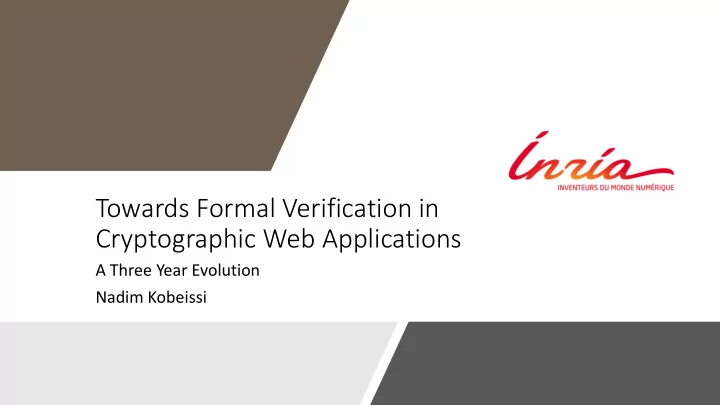

Towards Formal Verification in Cryptographic Web Applications A Three Year Evolution Nadim Kobeissi
• PROSECCO: Pro gramming Sec urely with C rypt o graphy. • Team at INRIA Paris specializing in applied cryptography and formal verification. • Goals: About Us • Formally delineate the patterns in which cryptographic flaws occur across all the world’s important protocols. • Develop technologies to minimize these flaws occurring again in the future, based on what we’ve learned.
Technologies • Major projects: • F*: ML programming language that lends itself to formal verification. • Dependent types, refinements, etc. • HACL* verified cryptography library, miTLS verified TLS implementation. • ProVerif : Automated protocol verification in the symbolic model. • Network execution under a Dolev-Yao attacker. • ProScript, TLS, Signal, ACME, Capsule, LDL… • CryptoVerif : Guided protocol verification with proofs in the computational model. • TLS, Signal, WireGuard …
Cryptographic Web Applications • Radical propulsion in market share: • Cryptocat: end-to-end encrypted chat with OTR (2011) • WhatsApp Web: end-to-end encrypted view into mobile device (2016) • Signal Desktop: Electron App (2017) • Skype: Electron App (2018)
Signal Protocol
Linking JavaScript Implementations to Verification Frameworks • ProScript: evolution from Defensive JavaScript (Antoine Delignat- Lavaud, 2014) into a full language: subset of JavaScript -> ProVerif
ProScript to ProVerif: Quick Example
Verification in ProVerif • Define a top-level process. • Define queries. • Execute over a network with an active attacker. • Protocol bugs: Key Compromise Impersonation. If Bob’s long -term secret and Bob’s signed pre -key is compromised, attacker can impersonate Alice to Bob. • Implementation bugs: missing HMAC check.
Verification in ProVerif • We verify: • Confidentiality. • Authenticity. • Forward secrecy. • Future secrecy. • Indistinguishability. • Absence of replay attacks.
ProVerif Trace: Capsule
Cryptographic Web Applications • Cryptocat (2016): • ProScript protocol core (Signal) • Translates and verifies in ProVerif • Manually proven in CryptoVerif • Trusted cryptographic core • The structure is there, but can we improve upon the individual components?
1 2 3 4 5 HACL-WASM! HACL: a Low*: a subset Kremlin: a Kremlin: now cryptographic of F* we can Low* to C also a Low* to • Native 64-bit operations: useful for library written compile to C. compiler. WASM Ed25519, Blake2b, etc. • Maintain constant-time in F*. compiler. and functional correctness properties. HACL-WASM: F* Primitives in WebAssembly
• HACL-WASM gives us perhaps the most high-assurance cryptographic primitives for the web. • Can we pair this with a protocol implementation from F*? • Integration: Signal, Skype, Cryptocat, Capsule. SignalStar and HACL-WASM
Conclusion Three years of following different complimentary approaches: advances in one branch leads to conclusions useful for another. In the future: generating full applications that are formally verified: protocol, primitives, etc. and facilitating availability to provers.
Recommend
More recommend